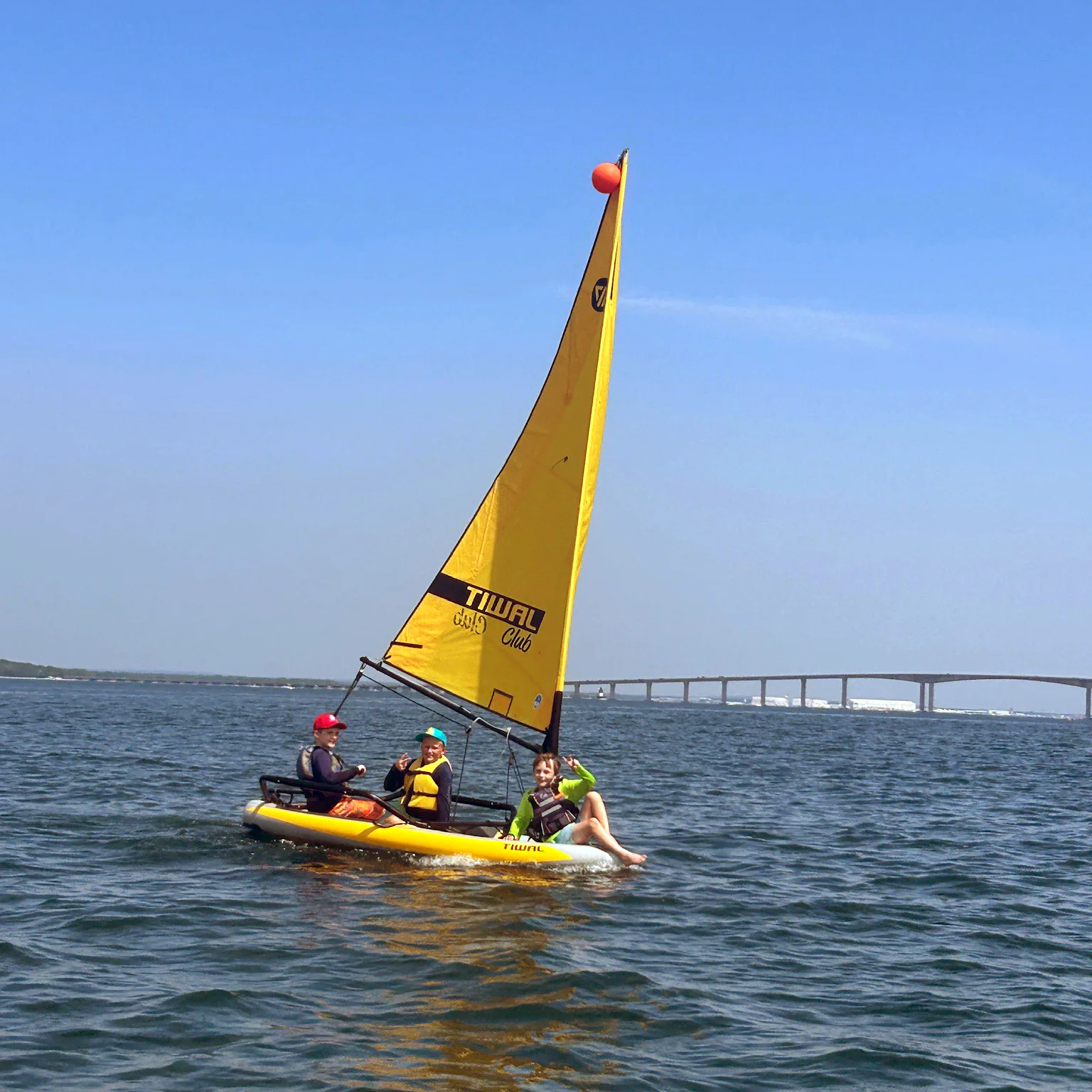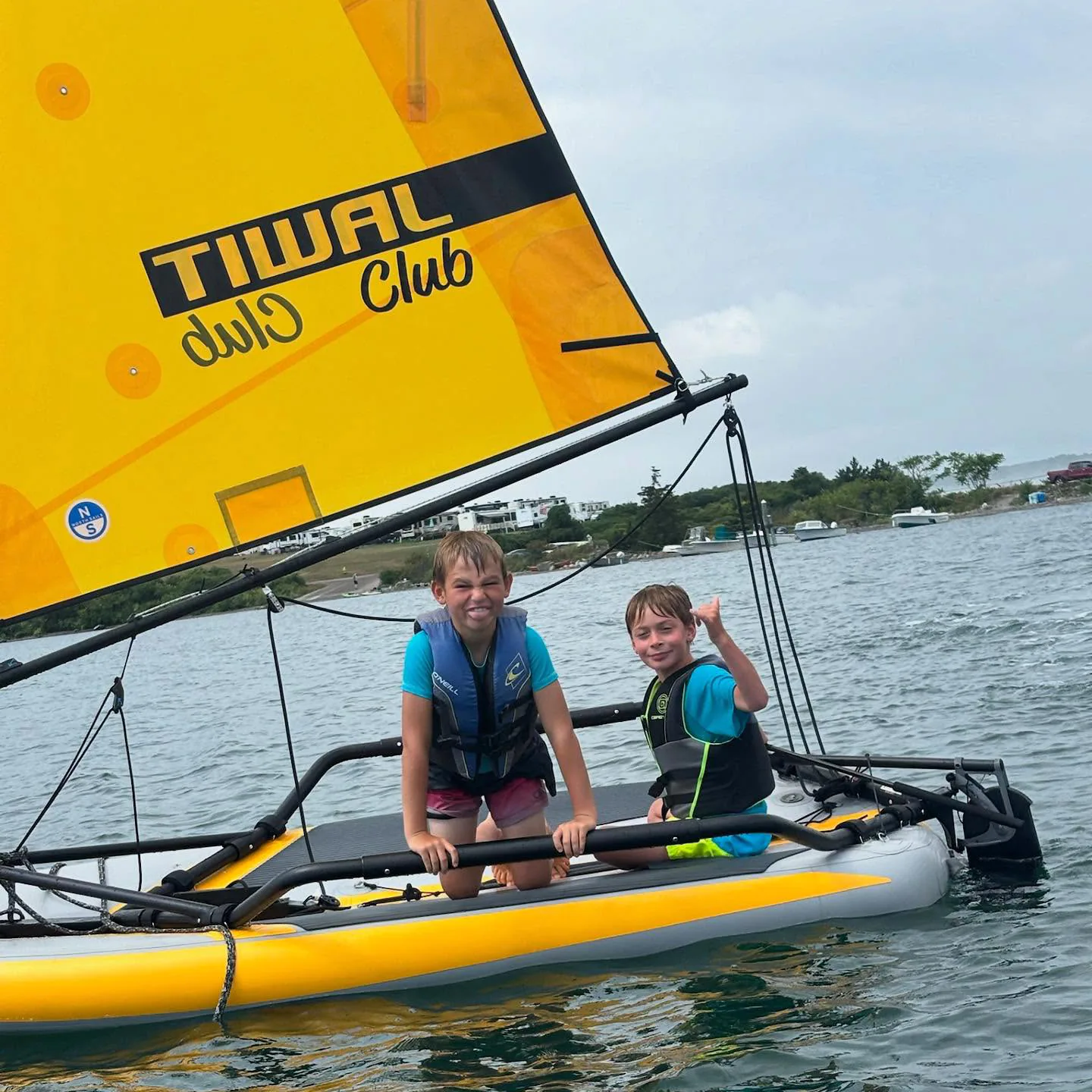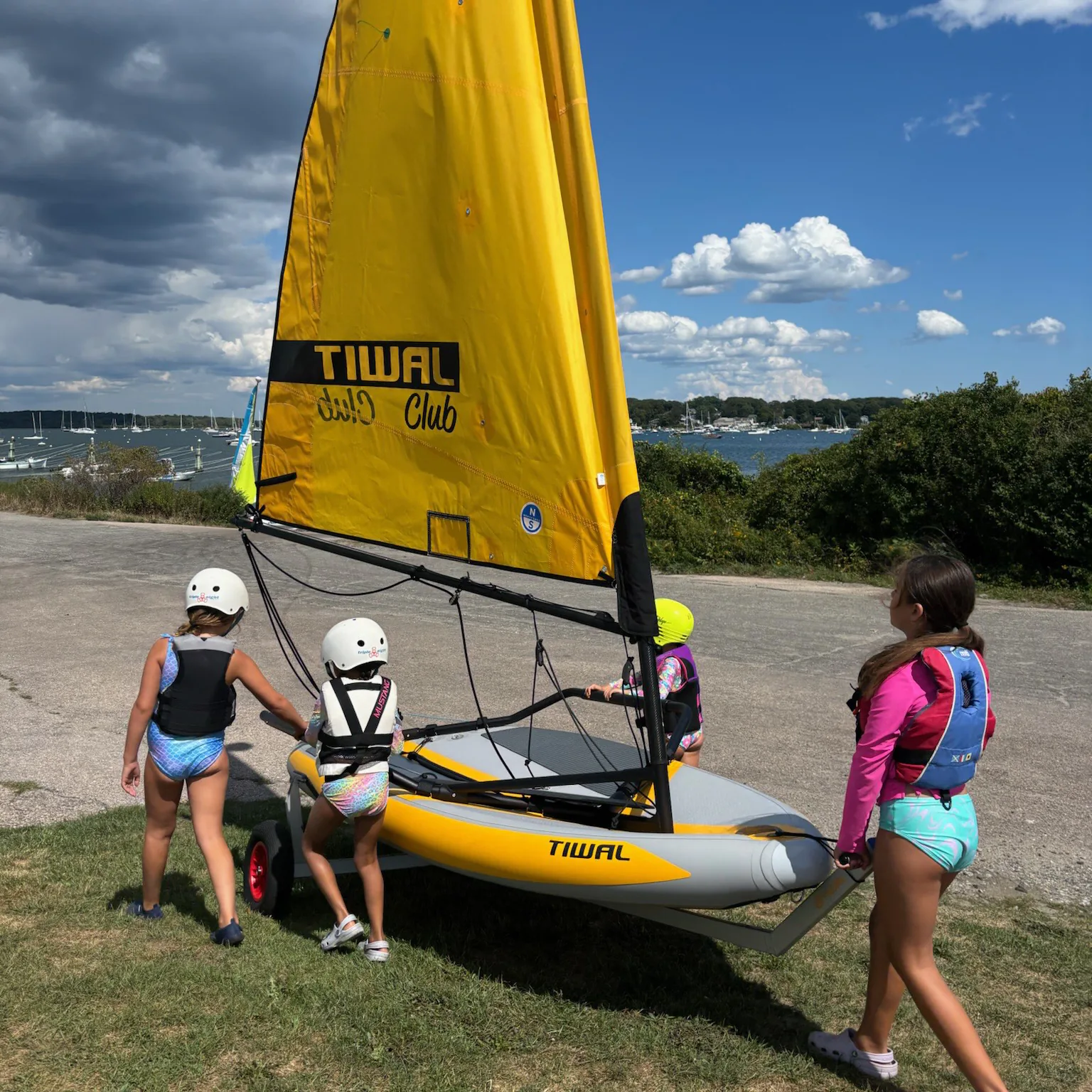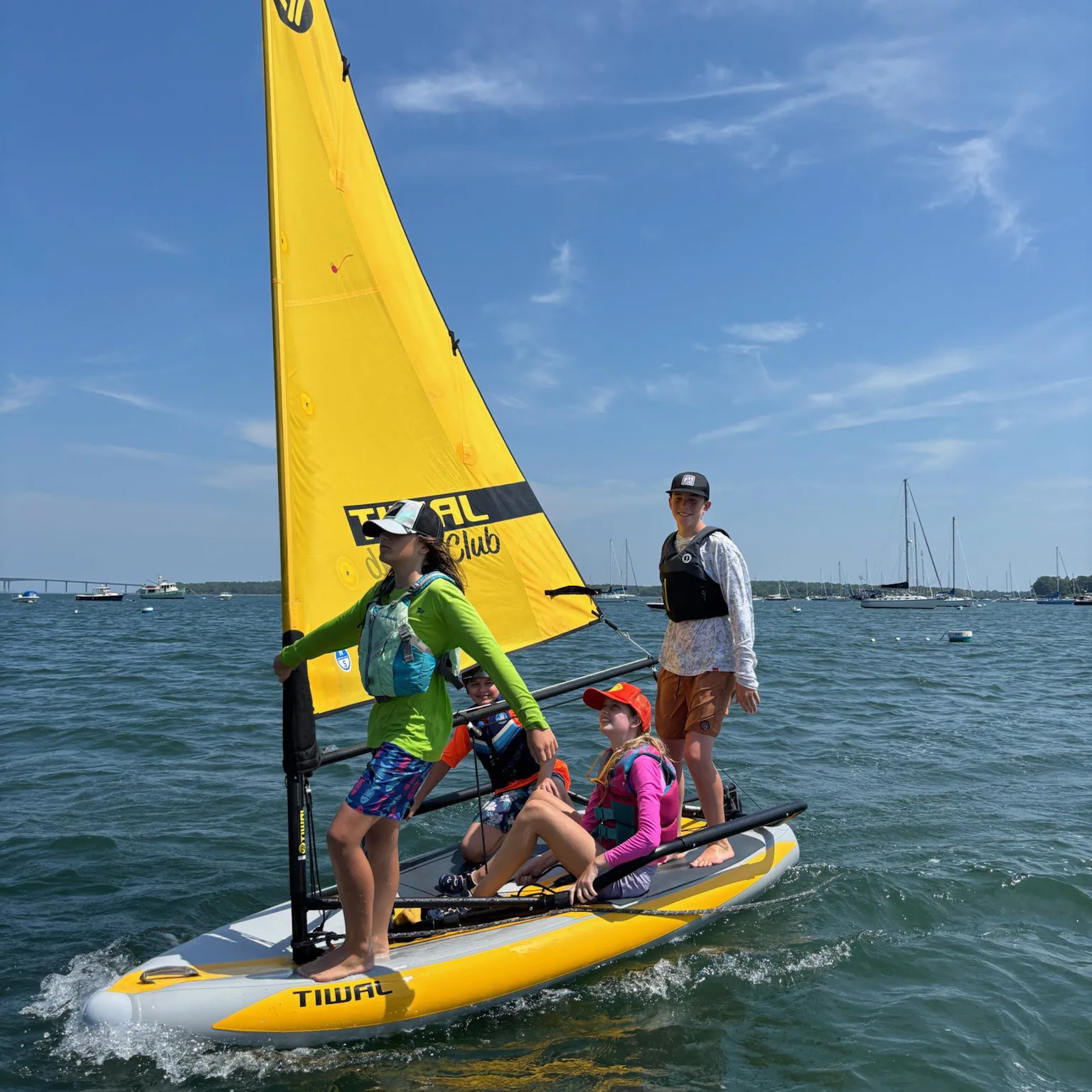Conanicut Island Sailing Foundation
Haley and Fiona from the Conanicut Island Sailing Foundation (CISF) highlight the Tiwal 3 as an ideal addition to their educational sailing fleet. They praise its versatility, comfort, and adaptability in various wind conditions.
Positioned between stable catamarans and unstable dinghies, the Tiwal allows instructors to sail with children, enhancing teaching. Its lightness promotes independence, as kids can handle it alone, while safety features like a high boom and no bailing after capsizing make learning enjoyable. Initially doubtful, CISF now trusts its durability. Its easy portability and compact storage perfectly suit the foundation’s limited space.
What is Conanicut Island Sailing Foundation?
Haley: We are a nonprofit based in Jamestown, Rhode Island, and our whole mission is to create access to the water through boating and sailing, and environmental education. We service not just people in our community, but the greater community of Rhode Island.
Which Tiwal model do you have?
Fiona: I think we have the Tiwal 3. We have two. We got one last year. And then this year we decided we really wanted another one, so we got another one.
What boat characteristics were you looking for?
Haley: When we tried out the Tiwal during a sailing conference two years ago, all three of us – we have another educator with us – we all tried it. And all of us knew, “This is it” “We love it”. One of our favorite parts is the comfortability of them. They’re so comfortable. What I really enjoyed is you can be kind of chill on them, but also when the wind picks up, you can hike out on them. So they really offer a lot of fun with wind and no wind, which is kind of a hard thing to find with boats.
Fiona: We do have certain classes where we use Open Bic and those smaller mono hull boats, as opposed to our regular Hobie Catamarans. It’s great to have a slightly larger boat that we can fit larger kids and also adults with a kid on the boat to help teach. Open Bic is difficult to fit multiple people and an adult on, so that really was a great thing for us to realize we can do a lot more with these boats in our programs. The fact that it can pack away really easily. When we first tried it out, we got help to break it down and pack it away, and we were amazed. We do not have a lot of space, so to be able to fit it well is a big deal for us.
Haley: And I have to say that they are good-looking boats!
Why is the Tiwal suited to your program?
Fiona: It really is a great platform for kids to gain more independence, because in our programs, we do a lot of adventure sailing on Hobie Catamarans where we are often with the kids. So to give them more practice on mono hull boats and a chance to be more independent and sail either alone or with a few other kids and gain that experience. It’s also just such a nice light boat. Kids can really wheel it down to the water. We have a bit of a walk to our water, so they can wheel it down there independently. It’s great for kids to use independently and gain that confidence.
Haley: All of our boats that we use, there is no bailing. In youth programming, I grew up bailing that Opti, and the fact that our campers never have to experience that is so nice. It’s because capsizing doesn’t feel overwhelming. It’s fun. So when kids are nervous about capsizing, we are like, “You just try it out. It’s so fun”. And then, they become really excited about capsizing.
What do the students think about the boat?
Haley: They love them. They absolutely love the Tiwal. I think, as Fiona said, the independence and the confidence that the children feel on the boat is why they love it, because they’re like, “I can take it out, no problem”. We encourage that. We say, “We saw you on the Tiwal yesterday, you look great. So you can take it out again today”. They have so much excitement for them. Last year when we had one, one Tiwal wasn’t enough, so we had to get two. Two really allowed us to have three kids on each Tiwal sometimes, and six kids are independently sailing or at least with their peers. They are able to share their knowledge on the boat and feel safe and confident.
Fiona: It’s a really good vehicle for kids to help teach other kids as well, because the kids who feel confident on there can take other kids sailing who might not have been on those boats before, and they feel good about that.
What do the sailing instructors think about the boat?
Fiona: It’s my favorite boat of ours, honestly. I think most of our instructors really love it. Compared to the Open Bic, most of our instructors don’t really fit on those boats, so they weren’t able to get the experience of sailing those boats with the kids. But it’s really easy for anyone to fit on the Tiwal. Also, the boom being so much higher. We do have helmets, but it makes it a lot less stress to be out there. You’re not worrying about kids getting hit. If you’re taller, you don’t have to do as much ducking. So I think it’s just very comfortable for all of us, and we all really enjoy taking it out.
Haley: Sailing’s not always comfortable. I think that it’s a really nice boat to find that balance of comfort. You can still get wet with the waves. Our campers love that aspect of the boats we offer, just getting wet with waves. The Tiwal is that really nice balance between the comfort of an inflatable boat and also being so close to the water.
Fiona: There’s also a good sense of play on it. That’s a big part of what we do, exploration and play. You can either be serious and really try to get it going fast, or you can have a kid standing on the front, bouncing around a little bit, but it still feels pretty stable and safe. I think that has been really great for our programs.
Haley: Definitely the stability of them. Our Hobie Cats are Catamarans, but they’re naturally stable, and then we have our Open Bic, who are not stable at all. I really feel that the Tiwal boats are a perfect in-between for the two boats we have had in our fleet for quite a few years.
What surprised you the most about the boat?
Haley: How great they are with being inflatable. I’ve been very pro-inflatable boats, whether it’s inflatable kayaks or paddle boards, just because I’ve been working with youth for 13 years. I see the struggle when they pull up those heavy boats and then kind of lose that confidence. The inflatable boats allow them to have that independence and not struggle. It has been so nice to see, and the durability of them. A durable, inflatable boat is fantastic.
Fiona: I agree. It’s hard to imagine an inflatable thing being very durable, but I definitely don’t feel worried about them getting holes or being ripped. They feel very, very strong and stable.
Haley: The advertisements you’ve had were good. I looked at your Instagram when we were figuring out if we wanted to try one out. Their advertisements show kind of rugged experiences.
Fiona: We can handle this.
Haley: Our children can be rugged. So that was nice to see the modeling in your advertising.
Fiona: Delicate boats don’t really work for us.
In what wind conditions do you use the Tiwal?
Haley: Any wind condition. I would say, maybe if it’s blowing over 15 knots, maybe not. The Tiwal works really well in no wind because it’s a fun platform to be on; kids can jump off and practice capsizing. But it’s also fun when there’s a lot of wind, and you can hike out on that bar and try going real fast.
Fiona: We had kids out in even windier than that this summer.
Haley: Okay, well then…
Fiona: It did get a little hectic, but they had a great time.
Haley: They feel safe.
Fiona: Yes.
Haley: And I think the stability allows them to…
Fiona: I even feel safer having them out in slightly windier conditions, because the boat is so light. I’m less worried about something going wrong if they capsize; it doesn’t feel dangerous to me.
What kind of users is the Tiwal best for?
Fiona: For us, it fits all our niches. We probably didn’t use it with our youngest kids.
Haley: Our youngest on the Tiwal were eight year olds this summer.
Fiona: I’d say kids who have had a bit of experience with sailing and are ready for a little bit more, especially for us. That might be independence, moving from a catamaran to a mono hull, or getting more of that capsizing experience. That’s been really great. Also, our higher-level classes where we push that independence more, like sailing higher-level concepts, we use those boats a lot for those older kids to get them practicing those concepts.
Haley: I’m sorry to say, but all. All ages could benefit from sailing the Tiwal. I would put young children on that boat with a skilled sailor for the experience. We just didn’t have that experience this summer, but I would fully be comfortable with that up until adults. Two of us would be comfortable on the boat. I enjoy being on a boat with more than just myself. That’s what I enjoy about Tiwal too. You can be independent and sail them alone, solo, no problem, but they’re comfortable enough to sail with more than one person.
How many students do you put on board the boat?
Fiona: From one to four. We’ve probably even had five kids, but that was probably a little bit more than is natural. I’d say four smaller kids. One to three is the perfect number.
Haley: On a no wind day we can easily put five kids on it for play. Whether they’re jumping off or practicing capsizing, five kids around 10 years old are having a great time. But for sufficient sailing time, three or four kids.
Fiona: One to three.
Haley: One, yes. Depending on the size of the kids, of course.
How is the Tiwal boat holding up?
Fiona: I don’t feel like there’s anything that is a concern of anything being broken or seeming damaged or worn down, besides maybe just our blades. That happens because once in a while kids hit the ground since we are in a shallow area. Even considering they are wooden, they are not that damaged. Even with scraping the ground sometimes, I’m not worried about them being usable. They’ve held up really well.
Haley: I really like the mechanism for the rudder, the ball. Having to describe that to kids, they pick that up really fast.
Fiona: It’s just one step, unlike a lot of putting down of rudders where you have to loosen one and tighten one. It really locks, which is so nice.
Do you think about sailing somewhere else with your fleet?
Haley: Any time there’s a video of someone sailing in the Caribbean, I wish it could just be us. Sailing along. It could be sailing through the more shallow waters.
Fiona: Just looking over at what’s in there.
Haley: When we first tried them out, we were in Savannah, Georgia, at a conference. One of our friends who was sailing it was actually following a dolphin. It was just her and a dolphin. That was pretty cool.
How do you store the boats in winter?
Haley: We disassemble them in their great, handy bags. Right now, we have a storage trailer where we are storing our boats. As an organization, we are in the process of getting a permanent building built right now. That answer will probably change, but currently, we keep our boats in a storage trailer.



